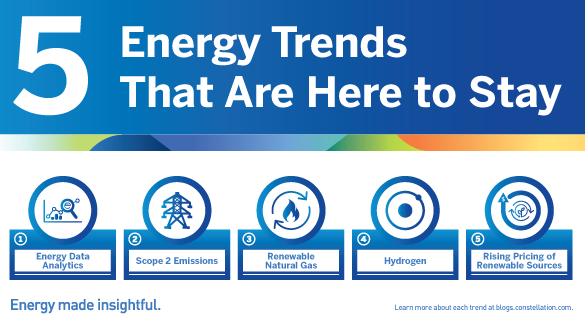Energy Trends that are Here to Stay: Sustainability Basics II
3 min readThe energy industry is evolving at a rapid speed. Driven by a combination of corporate environmental, social and governance (ESG) initiatives, competitive pressures, and compliance with new federal, regional or statewide policies, organizations are exploring the implementation of new sustainability strategies in their overall business strategy.
At Constellation, we strive to keep you apprised of the latest trends as they relate to energy, and most recently, sustainability. In a recent survey with Constellation customers, we learned that only 15% have a sustainability plan in place and 85% have limited knowledge of where to start or are just getting started with developing a strategy.
In the second blog in on our “Energy Trends that Are Here to Stay” series, we continue to discuss the meaning of energy trends that are increasingly common in industry news and that are quickly being adopted by businesses in an effort to increase their competitiveness.
Five important terms to know include:
Energy data analytics
Energy data analytics allow businesses to generate insights and inform strategies that can lead to both cost savings and sustainability. At a high level, data analytics platforms might allow customers to: 1) aggregate and verify energy bills; 2) simplify user experience; and 3) create strategies for optimizing carbon footprint, including understanding your baseline and tracking towards any goals, such as being carbon-free by 2050. Learn more about the benefits of integrating analytics into your energy strategy.
Scope 2 emissions
Scope 2 emissions represent indirect emissions from energy purchased from power plants that would power a business’ own facilities and equipment. “Although Scope 2 emissions physically occur at the facility where they are generated, they are [also] accounted for in an organization’s GHG inventory because they are a result of the organization’s energy use,” according to the EPA.1
To reduce Scope 2 emissions, voluntarily matching electricity supply requirements with a carbon-free power generation source supports the use of emission-free fuels and demonstrates a commitment to the environment. Learn more.
Renewable natural gas
Biogas is natural gas derived from the decomposition of organic matter and can be produced from landfills, agricultural and industrial waste digesters, and wastewater treatment plants. Biogas becomes renewable natural gas or “RNG” once cleaned (removal of non-methane components) and injected into a commercial pipeline system and can be used to produce heat and electricity.
Customers who use RNG may claim reductions in Scope 1 emissions if used to heat or power facilities or if used as an alternative for vehicle fuel and/or Scope 2 emissions if purchased through renewable energy certificates.

Hydrogen
Hydrogen is making headlines as a low-emission energy source and a cleaner alternative to natural gas usage and in diesel generators. Hydrogen can be cleaned through a process known as electrolysis and can be produced from a variety of sources, such as nuclear, wind and solar power.
In Aug. 2021, Exelon Generation was a recipient of a Department of Energy (DOE) grant to explore the potential benefits of onsite hydrogen production, which is a byproduct of nuclear energy production, at Nine Mile Point Nuclear Station in Oswego, New York. It could potentially be taken to market as a 100 percent carbon-free source of power for other purposes, including industrial applications such as transportation.
Rising price of renewable sources
Various economic factors have led to increased prices of renewable energy sources, including:
- The rising costs of labor due to construction companies being in higher demand than usual
- Supply chain challenges, such as:
- Federal trade policies that complicate the import of solar products such as the antidumping case involving Southeast Asia2 and the blocking of imports by China due to allegations of forced labor. This is significant as China is a major producer of polysilicon, which makes up solar cells.3
- The cost of transporting materials in shipping containers has risen significantly.4
- A rising cost of steel, which is used to create wind turbines.5
Despite these factors, renewable energy procurement continues to be a key part of an energy managers’ strategy. Constellation is available to help simplify the procurement process and provide transparency about the factors impacting pricing.
Stay tuned for the future posts in this new series by subscribing to our Biweekly Blog Update email (and check out other valuable communications) to stay on top of the latest energy trends and solutions to keep you ahead of your competition. Visit www.constellation.com/subscribe.
We invite you to take our quiz to tell us where you are in building and implementing your sustainability plan so we can better help you.
Sources
1. https://www.epa.gov/climateleadership/scope-1-and-scope-2-inventory-guidance
3. https://www.washingtonpost.com/business/2021/08/27/customs-detains-chinese-solar-panels/
4. https://www.wsj.com/articles/rising-shipping-costs-are-companies-latest-inflation-riddle-11631784602
5. https://www.wsj.com/articles/cost-inflation-is-blowing-through-the-wind-turbine-industry-11631264838
Based on current World Resources Institute (WRI) guidance. Scope 2 reporting claims of this product may be affected by future changes.

